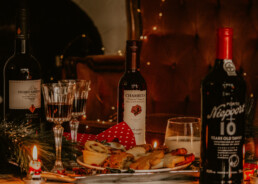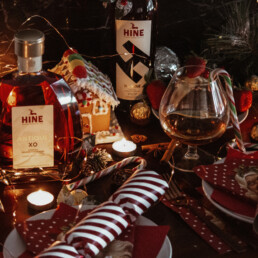There is something weirdly wrong going on in the world – no, not that obvious “wrong” that starts with a C – but when everyone is saying they want only dry wines! C’mon folks, deep down we know you really want to be sipping on a gem of sweet richness at the end of a great meal with family and friends. Yes, it’s time for change and to break out the liquid dessert – the sweet ambrosia – that’s fortified wines’ time to shine!
One of the most historically significant categories of wine, fortifieds, are made by adding grape spirit (brandy) to a wine either during or after fermentation, depending on whether the winemaker desires the finished wine to be dry or sweet. If a wine is fortified before fermentation is finished, the wine will be sweet, as there will still be sugar left in the wine itself, whereas a wine that is fortified after fermentation will be dry. The technique of fortification really came about during the Age of Exploration, when voyagers would strengthen their wines in order to withstand long ocean voyages (hence why many fortified wines today tend to be quite ageable). Wine drinkers grew to love the style, so the process stuck. Whether dry or sweet, fortified wines have one thing in common: high alcohol – not to mention giving the imbiber a joyful vinous epiphany.
Sherry
Even though your dear old gran used to drink it, sherry is now on the comeback path and considered one of the coolest, most versatile wines of the world. Often even wine lovers have steered clear of it because it can be a bit complicated and intimidating. That’s because sherry, produced in several different styles in the hot, southern Spanish region of Jerez, has many personalities, not just a singular character.
Three grapes may be used for the production of Sherry: Palomino Fino, which accounts for the majority of Sherry production, Pedro Ximénez (aka “PX”), and Moscatel. Sherry is also characterised by its unique solera aging system, in which older barrels of Sherry are topped up with younger wines from the system as wine is bottled from the oldest barrel, eventually leading to a blend of older and younger wines that technically contains wine from every single vintage since the solera system was first created.
While the many categories of Sherry can seem confusing, the easiest way to categorise them is in two ways: dry versus sweet, and oxidative versus non-oxidative.
Dry, non-oxidative Sherry such as Flor and Manzanilla is protected by a layer of yeast called flor, will have fresh but unique flavours such as almond, tart citrus, and saline, and should be drunk young.
Dry, oxidative Sherry such as Oloroso takes on a darker brown hue and develops notes of burnt caramel, coffee, and vanilla, making it seem sweet despite its lack of sugar.
Then there’s the in-between: dry, semi-oxidative Sherry, such as Amontillado and Palo Cortado, which have characteristics of both styles and have potential to age.
Finally, the sweet, oxidative styles: such as Cream, Moscatel, and Pedro Ximénez, all of which have significant sweetness, fig-like flavours and, in PX’s case, can age when made well.
Port
Like Sherry, Port also comes in a variety of style categories, but unlike Sherry, Port is always sweet and typically a red wine. Hailing from the terraced vineyards in Portugal’s Douro River Valley, Port is typically made from the local grape Touriga Nacional, along with other local supporting grapes. Though traditionally Port was vinified in the Douro Valley and then aged downriver in the famed Port houses of Vila Nova de Gaia, across the river from Porto, many smaller wineries now choose to age their Port where it is vinified in the Douro.
Styles of Port
Undoubtedly, one of the most fascinating aspects of Port wine is its variety of different styles, each with its own characteristic flavours, from the intense berry fruit flavours of a Reserve or a Late Bottled Vintage (LBV) to the rich mellowness of an Aged Tawny or the sublime complexity of a Vintage Port. These distinctive styles of Port derive essentially from the various ways in which it can be aged. Its remarkable ageing potential and the fact that it is fortified means that Port will continue to improve in cask, vat or bottle for much longer than most other wines.
There are, broadly speaking, two main distinctions for port wine: Bottle-aged Port & Cask-aged Port.
Cask-aged Ports are aged in wooden casks until they are perfectly ready to drink. Within the wood-aged Port family, there are three main styles:
- Full bodied, fruity red Ports which age for a relatively short time in large oak vats. These include Ruby Ports, usually aged in vat for two or three years, Reserve Ports which are generally of higher quality and age for slightly longer and Late Bottled Vintage Ports (LBV) which remain in vat for between four and six years. Although offering different degrees of complexity and sophistication, these wines share a deep red youthful colour and intense fruity flavours reminiscent of cherry, blackberry and blackcurrant.
- Rich and mellow Tawny Ports which age for longer periods in oak casks. These include the sumptuous 10, 20, 30 and 40 year-old Tawny Ports whose delicious nuttiness and aromas of butterscotch and fine oak wood intensify the longer they spend in wood. And Colheita Ports (aka Single Harvest Reserve) aged for a minimum of 7 years in small casks then released.
- White Ports, made from classic white Port grapes, which are usually aged for two or three years in large vats and are available in sweeter or drier styles. White Port is experiencing a revival at hip wine bars lately. It used to be a simple wine drunk almost exclusively by the port trade as an aperitif, with or without tonic water. But some Port companies are releasing half-bottles of seriously interesting cask-aged White Ports. Worth a try this summer!
The bottled-aged family of Ports is made up mainly of Vintage Port although it also includes a small category called Crusted Port & Single Quinta Port.
- Vintage Port represents the very best produce of a single outstanding year. It remains in vat for only about two years and then ages in bottle. Vintage Port is truly the pinnacle – powerful yet refined, magical yet worldly; harmoniously perfect. Vintage Port requires so long in bottle that the 1977s are only just coming around now. A new vintage, 2017, has just been “declared”, as they say in the business. This is the tradition that Port shippers would not announce their intention to bottle a Vintage Port until the wine has had two winters in cask and, of course, they have had a chance to see whether the subsequent vintage was better quality. Although Vintage Ports can be enjoyed when young, they will improve for many decades in the cellar and are among the most long-lasting of all wines.
- Crusted Ports are not made from wines of a single year but, like Vintage Ports, are capable of maturing in bottle. Also, like VP, they are not filtered before bottling and will form a ‘crust’ (natural sediment) in the bottle as they age. Dirk Niepoort calls this style “the offcuts of Vintage Port”.
- Single Quinta Ports are those Quintas (vineyards) that belong to a particular Port shipper and are made in ‘good’ years but not in outstanding ‘declared’ years. They are aged in wood for 2-3 years and bottled like VP without filtration. Often these wines are held back by shippers and only sold when the wine is considered ready to drink – up to 10 years after harvest!
Rutherglen Muscat
A burnished nectar of the gods so unique that our Aussie cousins have created a special category just for the liquid gold that is Rutherglen Muscat.
While uber-sweet, fortified wine may not be the first thought that comes to mind when envisioning the landscape of Australian wine, but, in fact, it has a long and distinguished history in fortified wines, winning international awards for its fortifieds since the 1870s. That success continues today. Rutherglen Muscat holds such historical significance, with many of the region’s producers in their fourth or fifth generation of winemaking.
In this hot region of Victoria, about three hours northeast of Melbourne, the reddish-skinned white grape Muscat Rouge à Petits Grains is left to hang on the vine to gain concentrated sugars throughout most of the harvest season.
Fortified during the fermentation process, much of this sugar remains in the wine, which is then aged oxidatively in barrel, creating a rich, walnut-brown coloured, lusciously sweet wine with intense flavours: raisin, prunes, apricots, burnt caramel, coffee, toasted nuts and more.
The youngest Rutherglen Muscats are usually no younger than five years, but the best versions are aged for decades. These wines are a national vinous treasure.
Hanging mistletoe will not be needed with wine gifts like these… there’ll be plenty of kisses coming your way after buying a sexy divine fortified wine like Chambers Rosewood Vineyards Rutherglen Grand Muscat from Dhall & Nash.
“Here the wine emerges as a perfect example of muscat, supple and smooth in one moment, wildly exotic and energetic the next, playing tricks on the palate – just an excuse to have another sip, of course, the length of the wine is prodigious, as is its balance, but the orchestra of Christmas pudding, Turkish delight and high-toned spices plays on.” – James Halliday on Chambers Grand Muscat (96 points)
“…anyone who has ever tasted Chambers Fortified Tokay or Muscat realises the world’s reference point for these wines begins and ends with Chambers.” – Robert Parker’s The Wine Advocate
Jancis Robinson has described Rutherglen Muscat as “…some of the most extraordinary in the world, and nowhere else has the vine stocks and arid climate to grow and mature anything like them.”
Merry Delish-mas








